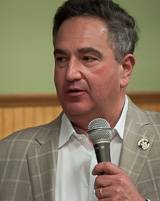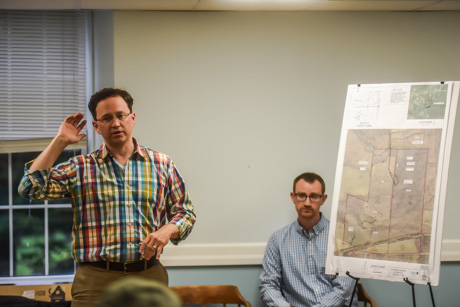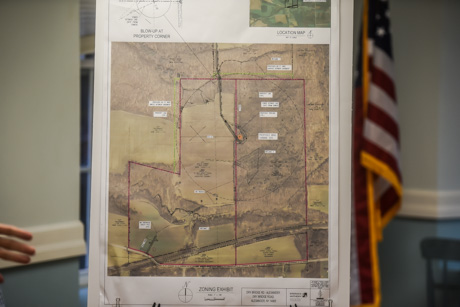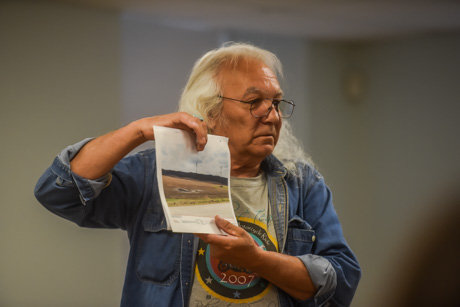A proposed 650-foot tall, 4.5-megawatt wind turbine proposed for Dry Bridge Road in Alexander met some opposition at a Zoning Board of Appeals meeting last week.
Some residents said it wasn't needed, they didn't want it, questioned the financial benefit to the town, and suggested it would be an eyesore.
The community-based energy project -- meaning town, village, and school district receive fees and residents get a discount on electricity -- would be constructed by Borrego Energy on property owned by Dale and Brenda Spring. Representatives of Borrego, which included Dave Strong, Brandon Smith and Mark Kenworth, explained the project.
The Spring property is 147 acres and the windmill will be on the northern portion of the property, about 1,954 feet north of Dry Bridge Road and 4,136 feet south of Route 20.
The project will disturb only 8.5 acres of the property, and it came before the ZBA because the town code prohibits wind turbines taller than 500 feet.
Strong explained that each new generation of turbines gets taller and taller, and no developer builds turbines shorter than 500 feet. The new standard is 650 feet and windmills are getting taller across the country and around the world.
There are no dwellings or structures on the Spring property.
"This is the smallest we could go to make a project like this work economically," Strong said. "The wind turbine towers have gotten a little bit taller every decade, not too much, but they keep getting a little bit taller."
That's because of improved technology, he said.
"The thing that's gotten really efficient is the blades. The blades are now made of, like, carbon fiber material. They're very light. You can make them longer and longer."
The improved technology means the days of large windmill farms are coming to a close, Strong suggested.
"It's important to note that we can do one wind turbine where you used to have to do five or six," Strong said. "You'd have to spread them out and they were shorter, like the ones in Orangeville. We're way beyond those wind turbines."
The turbine will be tall
One resident questioned why "little Alexander" needed such a big windmill.
"This is is 650 feet," he said. "It is double the height of the Empire State Building. It isn't going to give us that much more joy in this community than having two Empire State Buildings stacked on top of one another. I mean, let's be honest here. This is all about money. It's all about money.
Actually, the Empire State Building is twice as tall as the proposed windmill at 1,250 feet, not including the spire.
The height of the windmill is why a ZBA variance is required. Smith said the local code was probably written before technology pushed windmills higher and when available air traffic control made anything taller an issue for Federal Aviation Administration.
"Back when the bylaw was written, there was this idea that 500 was kind of the limit that the FAA would approve," Smith said.
The FAA will review plans for this turbine, Smith said, but he suggested it is likely to be approved.
The height is also a concern of John Volpe, who suggested Borrego's renderings of the proposed windmill are misleading, showing its proximity to a telephone pole in the foreground off Route 20.
He suggested a better comparison was his own rendering of a two-story house, 20-feet tall, next to the 650-foot tall windmill.
Environmental concerns
An environmentalist, Volpe also said there is a community of endangered plants on the Spring property that isn't addressed in documents provided by Borrego.
"I hope the zoning board will understand that this little community that's for special plants, very endangered plants, everything like this is extremely important, especially when there are only 80 other communities within the whole world," he said.
Volpe claimed that Borrego's survey for endangered plants was made on Nov. 18 when most plants are dormant.
Cory Mower paid his respects to the property owner, Spring, whose family has been in Alexander for multiple generations but said he is opposed to the proposal.
"He has his own road name, you know, but this is just ridiculous in my mind as one of the closest houses if not the closest house (to the project)," Mower said. "This is 650 feet tall. I know for a fact there's a hawk nest not 500 feet from there and there's got to be more. There are eagles, too. There are eagles all over the place, not to mention the other animals that these things kill. I understand money. I understand where this is coming from, but I just can't have it. I mean, I can't."
There are significant environmental regulations for Borrego to navigate, Smith suggested, and the company is working close with the Department of Environmental Conservation to address environmental concerns.
"We've been in close contact with them," Smith said. "As for the impact eagles, birds, =grassland birds, all those sorts of things, we've been working with them to obtain permits and understand the impacts and what we can do to mitigate. For example, bats, as we all know, aren't out in a hurricane.They're out on calm summer nights. Those times we are actually going to curtail, we're going to shut down the turbine at those low wind speeds during the summer when we know bats will be out to try to minimize as much as possible any impact in bats."
Windmills need wind
Some residents questioned whether there was enough wind in Alexander to power such a large turbine.
Yes, in summertime the wind dies down, but in spring, fall, and winter, there is ample wind, Strong said.
"Especially these modern wind turbines with very light carbon fiber blades. Believe it or not, they can make decent electricity even in really light winds," Strong said. "The other thing is, once you get up above the trees, which is one of the reasons we kind of have to go tall, that wind actually is much more consistent than it is when you're down on the ground."
The best deal possible for Alexander
Borrego is building the windmill but won't necessarily own it, Smith said. It could be sold to another company, maybe.
The cost of the project will exceed $4 million, with $3 million being spent just on the turbine.
While the local government agencies will receive fees from the project over the next 15 years, it's not going to be a windfall for the town, Strong said. He said it's too soon in the project planning to nail down financial returns. He estimated the town will get from $250,000 to $300,000 from the project, or about $20,000 a year, plus another $8,000 in payment in lieu of taxes (that will be part of the economic development tax-incentive package that GCEDC could grant to the project).
That $28,000 is about the same amount the town, Strong indicated, had to increase its spending by this past year.
There are no state subsidies on this project.
"Wind turbines are, they are not cheap," Strong said. "They're made to last for a long time."
With inflation and supply chain issues being what they are, it's a tough financial environment for renewable energy projects.
"(Wind companies) are actually having trouble staying profitable," Strong said. "I don't know how much money they would make (on this project). It's GE's investment and they're no dummies. I'm sure they will make enough money, but they're not making a heck of a lot of money these days. As far as a proportion of what the town will get, I will say of all wind and solar projects in the state, this is definitely the best deal per megawatt that exists."
It's good he said, because sites appropriate to a project like this are hard to find in New York. You need decent wind, a parcel big enough to be safe, and a zoning code that works for the proposed scope of the project.
"There are not many of these sites in the state, so with respect to what kind of deal the town is getting, it's the best deal going," Strong said.
Support
Among the few voices in support of the project was Don Partridge, a property owner in Alexander but a resident of Batavia, where he has three small windmills on his property.
"My carbon footprint is zero," Partridge said.
He noted that since the 1920s, there have been telephone and utility poles up and down area roadways, but nobody ever thinks of them as unsightly. He suggested people will adjust to the presence of a windmill in Alexander.
"I think you need to keep an open mind and how we're going to advance our environment in the future with more and more demands for electricity," Partridge said. "I am in favor of the project."
Top photo, Dave Strong and Brandon Smith.
Photos by Howard Owens
John Volpe




